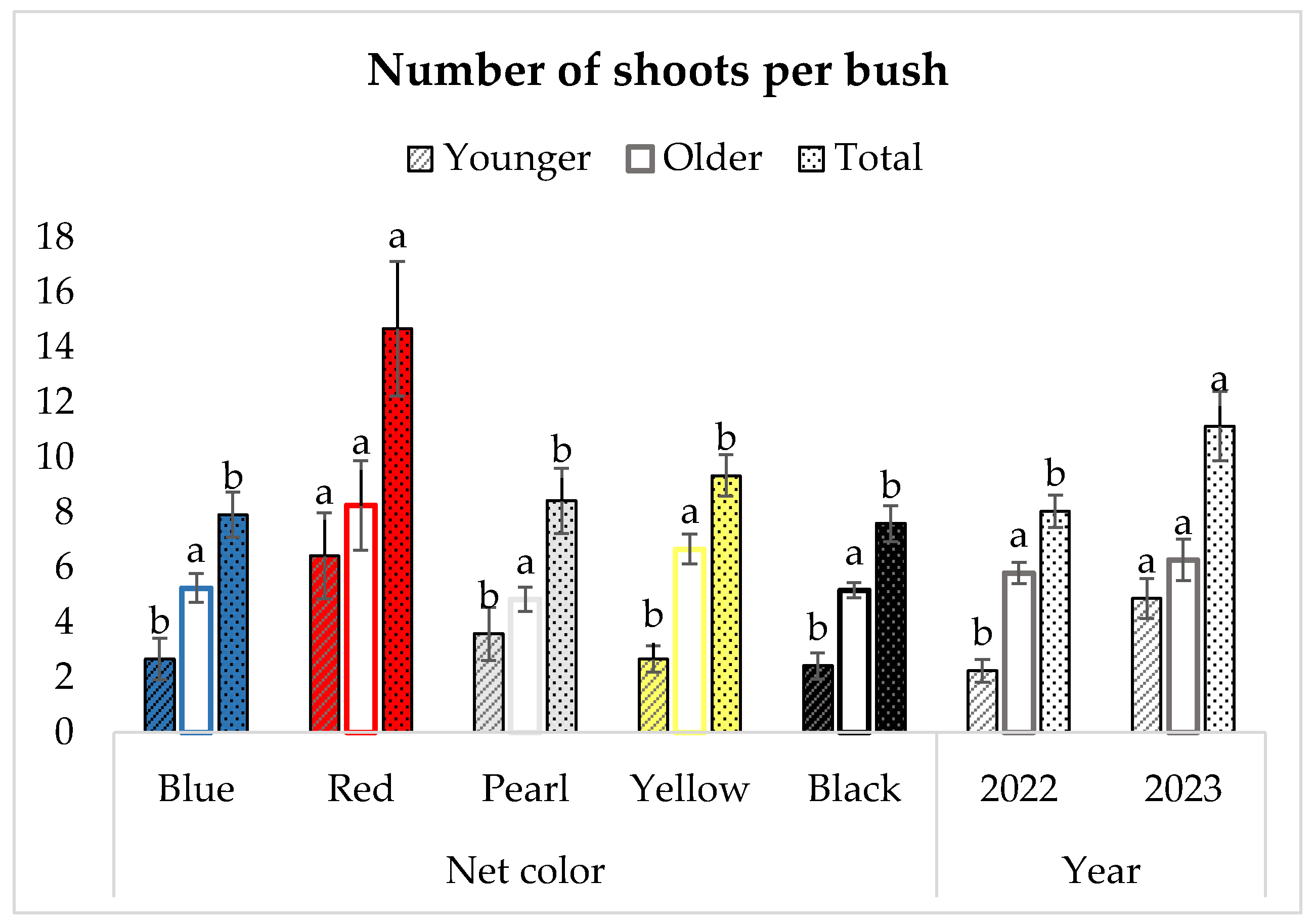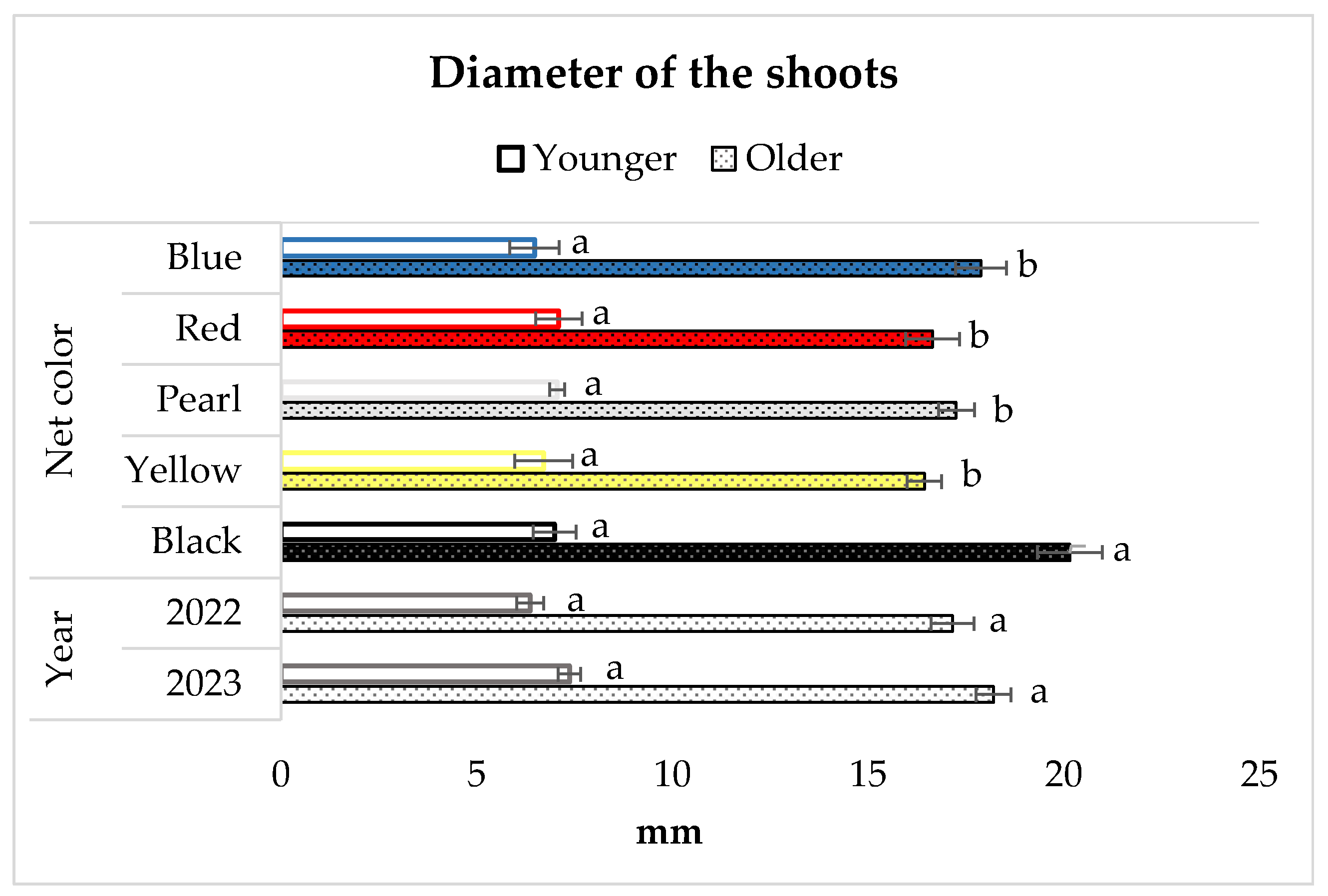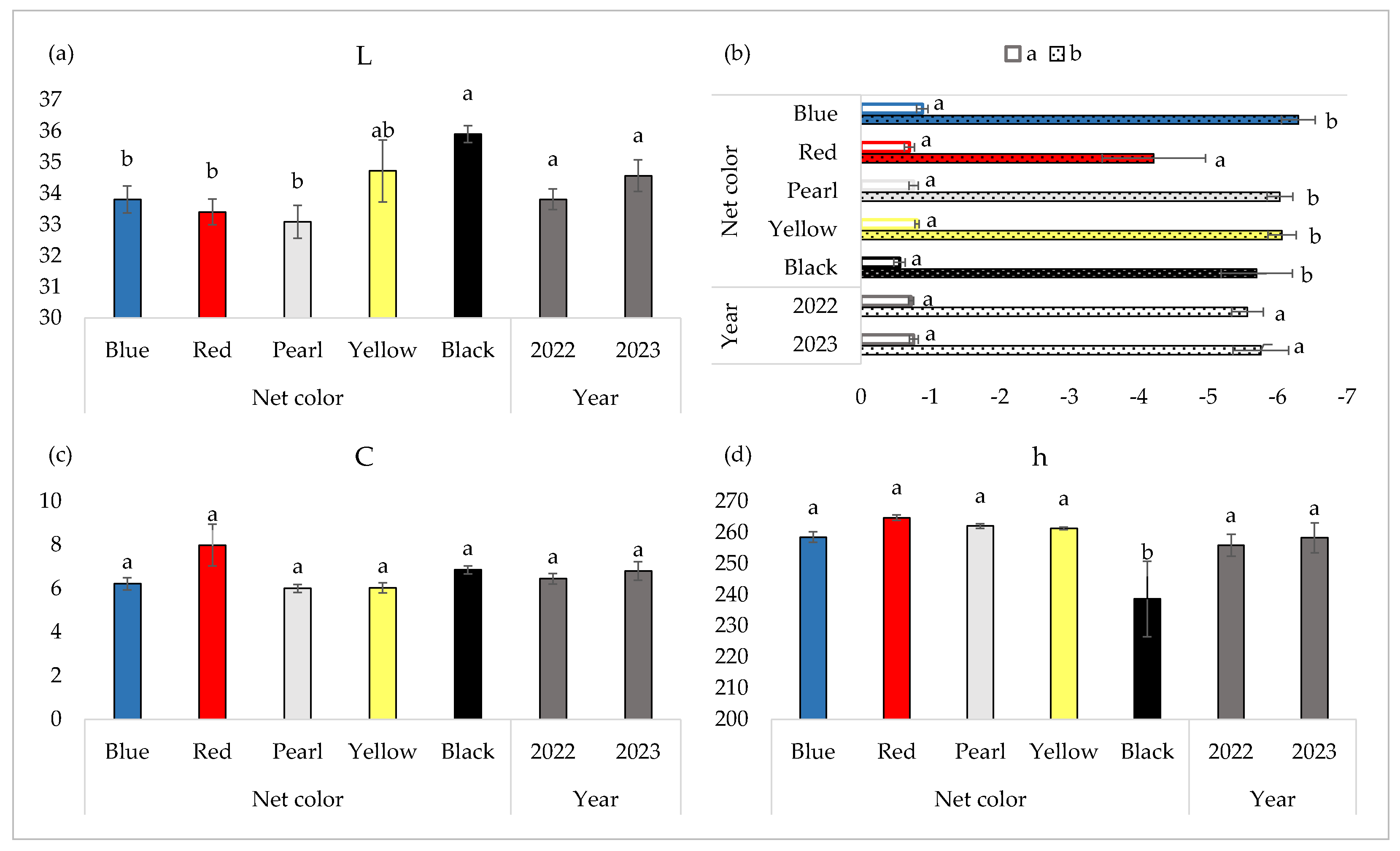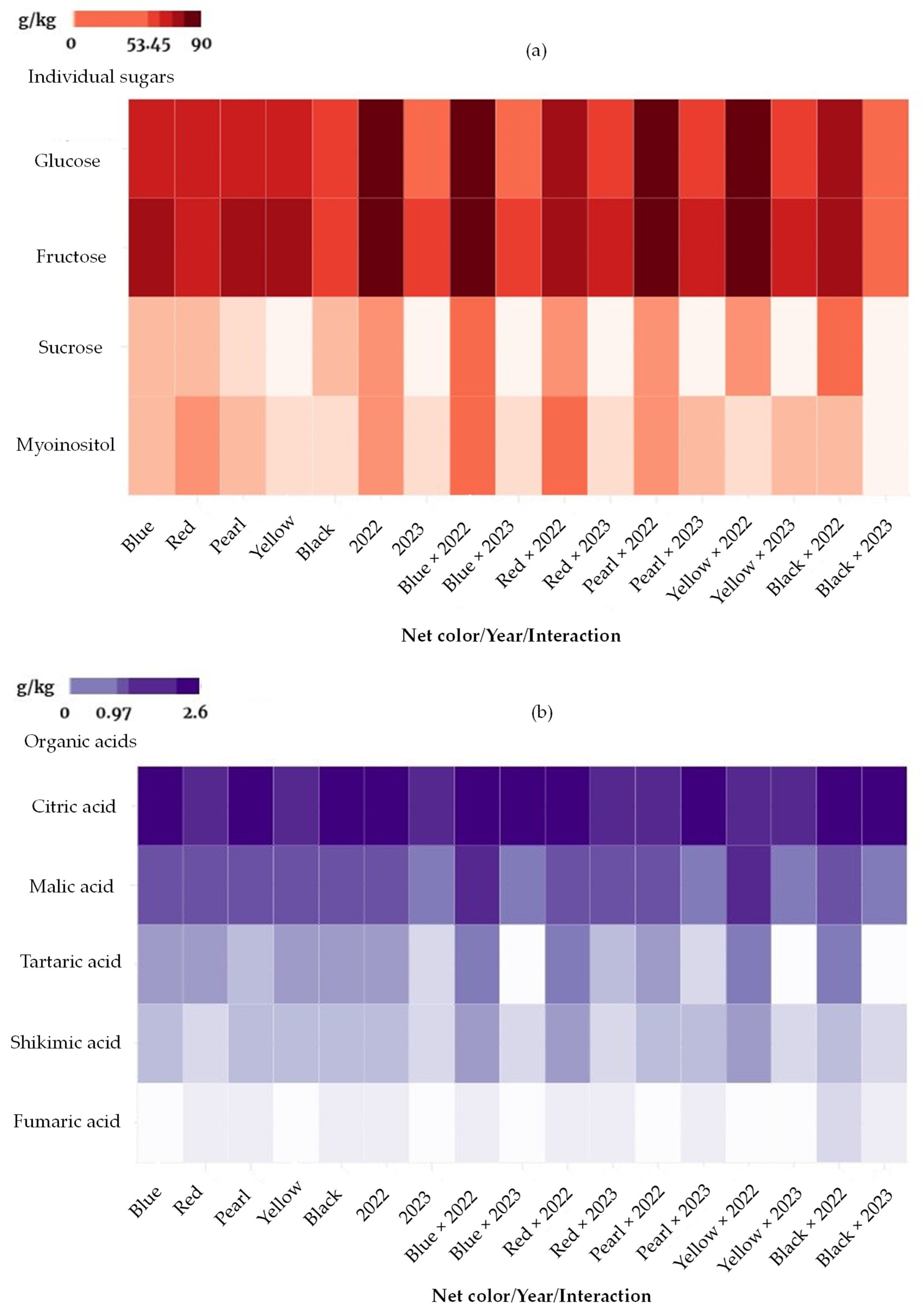Differentially Colored Photoselective Nets as a Sophisticated Approach to Improve the Agronomic and Fruit Quality Traits of Potted Blueberries
Abstract
1. Introduction
2. Materials and Methods
2.1. Experimental Design and Net Properties
2.2. Microclimate Measurement
2.3. Vegetative- and Yield-Related Traits
2.4. Fruit Sampling
2.5. Biometrical Fruit Traits and Texture Analysis
2.6. Fruit Color Evaluation
2.7. Total Soluble Solids (TSSs) and Titratable Acidity (TA) Determination
2.8. Individual Sugar and Organic Acid Extraction and Determination
2.9. Sweetness Index (SI)
2.10. Total Quality Index (TQI)
2.11. Statistical Analysis
3. Results
3.1. Microclimate Conditions
3.1.1. Effect of Differentially Colored Photoselective Nets on PPFD
3.1.2. Effect of Differentially Colored Photoselective Nets on Air Temperature
3.2. Vegetative- and Yield-Related Characteristics
3.3. Ripening Time, Biometrical, and Textural Fruit Properties
3.4. Fruit Color
3.5. TSS, TA, TSS/TA, and SI
3.6. Content of Individual Sugar Types and Organic Acids
3.7. TQI
4. Discussion
5. Conclusions
Supplementary Materials
Author Contributions
Funding
Data Availability Statement
Acknowledgments
Conflicts of Interest
Abbreviations
| PPFD | Photosynthetic Photon Flux Density |
| EC | Electrical Conductivity |
| TSS | Total soluble solids |
| TA | Titratable acidity |
| SI | Sweetness index |
References
- Milivojević, J.; Maksimović, V.; Radivojević, D.; Spasojević, S.; Dragišić Maksimović, J. How does fertilizer management strategy in soilless blueberry cultivation change the phytochemical profile and phenoloxidases activity during fruit ripening? J. Sci. Food Agric. 2024. early view. [Google Scholar] [CrossRef]
- Dragišić Maksimović, J.; Milivojević, J.; Djekić, I.; Radivojević, D.; Veberič, R.; Mikulič Petkovšek, M. Changes in quality characteristics of fresh blueberries: Combined effect of cultivar and storage conditions. J. Food Compos. Anal. 2022, 111, 104597. [Google Scholar] [CrossRef]
- Zhang, J.; Nie, J.; Li, J.; Zhang, H.; Li, Y.; Farooq, S.; Bacha, S.A.S.; Wang, J. Evaluation of sugar and organic acid composition and their levels in highbush blueberries from two regions of China. J. Integr. Agric. 2020, 19, 2352–2361. [Google Scholar] [CrossRef]
- Okan, O.T.; DeniZ, İ.; Yayli, N.; Şat, İ.G.; Öz, M.; HatiPoğlu Serdar, G. Antioxidant activity, sugar content and phenolic profiling of blueberries cultivars: A comprehensive comparison. Not. Bot. Horti. Agrobo. 2018, 46, 639–652. [Google Scholar] [CrossRef]
- FAOSTAT. Crops and Livestock Products. 2023. Available online: https://www.fao.org/faostat/en/#data/QCL/visualize (accessed on 15 January 2025).
- Milivojević, J.; Radivojević, D.; Ruml, M.; Dimitrijević, M.; Dragišić Maksimović, J. Does microclimate under grey hail protection net affect biological and nutritional properties of ‘Duke’ highbush blueberry (Vaccinium corymbosum L.)? Fruits 2016, 71, 161–170. [Google Scholar] [CrossRef]
- Vuković, M.; Jurić, S.; Maslov Bandić, L.; Levaj, B.; Fu, D.-Q.; Jemrić, T. Sustainable food production: Innovative netting concepts and their mode of action on fruit crops. Sustainability 2022, 14, 9264. [Google Scholar] [CrossRef]
- Castellano, S.; Scarascia Mugnozza, G.; Russo, G.; Briassoulis, D.; Mistriotis, A.; Hemming, S.; Waaijenberg, D. Plastic nets in agriculture: A general review of types and applications. Appl. Eng. Agric. 2008, 24, 799–808. [Google Scholar] [CrossRef]
- Shahak, Y.; Ratner, K.; Giller, Y.E.; Zur, N.; Or, E.; Gussakovsky, E.E.; Stern, R.; Sarig, P.; Raban, E.; Harcavi, E.; et al. Improving solar energy utilization, productivity and fruit quality in orchards and vineyards by photoselective netting. Acta Hortic. 2008, 772, 65–72. [Google Scholar] [CrossRef]
- Arthurs, S.P.; Stamps, R.H.; Giglia, F.F. Environmental modification inside photoselective shadehouses. Horts 2013, 48, 975–979. [Google Scholar] [CrossRef]
- Shahak, Y.; Gussakovsky, E.E.; Cohen, Y.; Lurie, S.; Stern, R.; Kfir, S.; Naor, A.; Atzmon, I.; Doron, I.; Greenblat-Avron, Y. Colornets: A new approach for light manipulation in fruit trees. Acta Hortic. 2004, No. 636, 609–616. [Google Scholar] [CrossRef]
- Shahak, Y. Photoselective netting: An overview of the concept, research and development and practical implementation in agriculture. Acta Hortic. 2014, 1015, 155–162. [Google Scholar] [CrossRef]
- Ordóñez, V.; Molina-Corral, F.J.; Olivas-Dorantes, C.L.; Jacobo-Cuéllar, J.L.; González-Aguilar, G.; Espino, M.; Sepulveda, D.; Olivas, G.I. Comparative study of the effects of black or white hail nets on the fruit quality of ‘Golden Delicious’ apples. Fruits 2016, 71, 229–238. [Google Scholar] [CrossRef][Green Version]
- Amarante, C.V.T.; Steffens, C.A.; Zanardi, O.Z.; Miqueloto, A.; Santos, H.P. Light supply to ‘Fuji’ apple trees covered with hail protection nets and its effects on photosynthesis, yield and fruit quality. Rev. Bras. Frutic. 2009, 31, 664–670. [Google Scholar] [CrossRef]
- Guerrero, V.; Orozco, J.; Romo, A.; Gardea, A. The effect of hail nets and ethephon on color development of ’Redchief Delicious’ apple fruit in the highlands of Chihuahua, Mexico. J. Am. Pomol. Soc. 2002, 56, 132. [Google Scholar]
- Hogewoning, S.W.; Trouwborst, G.; Maljaars, H.; Poorter, H.; Van Ieperen, W.; Harbinson, J. Blue light dose-responses of leaf photosynthesis, morphology, and chemical composition of Cucumis sativus grown under different combinations of red and blue light. J. Exp. Bot. 2010, 61, 3107–3117. [Google Scholar] [CrossRef]
- Iglesias, I.; Alegre, S. The effect of anti-hail nets on fruit protection, radiation, temperature, quality and probability of Mondial Gala apples. J. Appl. Hortic. 2006, 8, 91–100. [Google Scholar] [CrossRef]
- Bosco, L.C.; Bergamaschi, H.; Cardoso, L.S.; Paula, V.A.D.; Marodin, G.A.B.; Brauner, P.C. Microclimate alterations caused by agricultural hail net coverage and effects on apple tree yield in subtropical climate of southern Brazil. Bragantia 2017, 77, 181–192. [Google Scholar] [CrossRef]
- Solomakhin, A.A.; Trunov, Y.V.; Blanke, M.; Noga, G. Environmental changes under hail protective nets with different colouration affect fruit quality. Acta Hortic. 2012, 932, 231–237. [Google Scholar] [CrossRef]
- Brglez Sever, M.; Tojnko, S.; Breznikar, A.; Skendrović Babojelić, M.; Ivančič, A.; Sirk, M.; Unuk, T. The influence of differently coloured anti-hail nets and geomorphologic characteristics on microclimatic and light conditions in apple orchards. J. Cent. Eur. Agric. 2020, 21, 386–397. [Google Scholar] [CrossRef]
- Basile, B.; Giaccone, M.; Shahak, Y.; Forlani, M.; Cirillo, C. Regulation of the vegetative growth of kiwifruit vines by photo-selective anti-hail netting. Sci. Hortic. 2014, 172, 300–307. [Google Scholar] [CrossRef]
- Lobos, G.A.; Retamales, J.B.; Hancock, J.F.; Flore, J.A.; Romero-Bravo, S.; Del Pozo, A. Productivity and fruit quality of Vaccinium corymbosum cv. Elliott under photo-selective shading nets. Sci. Hortic. 2013, 153, 143–149. [Google Scholar] [CrossRef]
- Smrke, T.; Grohar, M.C.; Indihar, E.; Veberic, R.; Jakopic, J. Does photoselective netting influence ripening, maturity parameters and chemical composition of highbush blueberry (Vaccinium corymbosum L.) fruit? Sci. Hortic. 2024, 337, 113555. [Google Scholar] [CrossRef]
- Fan, X.-X.; Xu, Z.-G.; Liu, X.-Y.; Tang, C.-M.; Wang, L.-W.; Han, X. Effects of light intensity on the growth and leaf development of young tomato plants grown under a combination of red and blue light. Sci. Hortic. 2013, 153, 50–55. [Google Scholar] [CrossRef]
- Zoratti, L.; Karppinen, K.; Luengo Escobar, A.; Haggman, H.; Jaakola, L. Light-controlled flavonoid biosynthesis in fruits. Front. Plant Sci. 2014, 5, 534. [Google Scholar] [CrossRef]
- Meteomanz. 2025. Available online: http://www.meteomanz.com/index?l=1 (accessed on 15 January 2025).
- Giongo, L.; Poncetta, P.; Loretti, P.; Costa, F. Texture profiling of blueberries (Vaccinium spp.) during fruit development, ripening and storage. Postharvest Biol. Technol. 2013, 76, 34–39. [Google Scholar] [CrossRef]
- Mokrzycki, W.S.; Tatol, M. Colour difference ΔE—A survey. Mach. Graph. Vis. 2011, 20, 383–412. [Google Scholar]
- Milosavljević, D.; Maksimović, V.; Milivojević, J.; Djekić, I.; Wolf, B.; Zuber, J.; Vogt, C.; Dragišić Maksimović, J. Sugars and organic acids in 25 strawberry cultivars: Qualitative and quantitative evaluation. Plants 2023, 12, 2238. [Google Scholar] [CrossRef]
- Keutgen, A.; Pawelzik, E. Modifications of taste-relevant compounds in strawberry fruit under NaCl salinity. Food Chem. 2007, 105, 1487–1494. [Google Scholar] [CrossRef]
- Spasojević, S.; Maksimović, V.; Milosavljević, D.; Djekić, I.; Radivojević, D.; Sredojević, A.; Milivojević, J. Variation in chemical, textural and sensorial traits among remontant red raspberry (Rubus idaeus L.) cultivars maintained in a double-cropping system. Plants 2024, 13, 3382. [Google Scholar] [CrossRef]
- Zhang, Y.; Chu, B.; Zhang, D.; Li, Q.; Li, Q.; Li, X.; Liu, Z.; Ma, F.; Guan, Q.; Zhang, D.; et al. Effects of four photo-selective colored hail nets on an apple in loess Plateau, China. Horticulturae 2023, 9, 1061. [Google Scholar] [CrossRef]
- Pandey, G.; Parks, S.; Thomas, R.G. Polymer and photo-selective covers on plant and fruit development: A review. Agron. J. 2023, 115, 3074–3091. [Google Scholar] [CrossRef]
- Retamales, J.B.; Montecino, J.M.; Lobos, G.A.; Rojas, L.A. Colored shading nets increase yields and profitability of highbush blueberries. Acta Hortic. 2008, 770, 193–197. [Google Scholar] [CrossRef]
- Zoratti, L.; Jaakola, L.; Häggman, H.; Giongo, L. Modification of sunlight radiation through colored photo-selective nets affects anthocyanin profile in Vaccinium spp. Berries. PLoS ONE 2015, 10, e0135935. [Google Scholar] [CrossRef] [PubMed]
- Serra, S.; Borghi, S.; Mupambi, G.; Camargo-Alvarez, H.; Layne, D.; Schmidt, T.; Kalcsits, L.; Musacchi, S. Photoselective protective netting improves “Honeycrisp” fruit quality. Plants 2020, 9, 1708. [Google Scholar] [CrossRef]
- Brkljača, M.; Rumora, J.; Vuković, M.; Jemrić, T. The Effect of photoselective nets on fruit quality of apple cv.‘Cripps Pink’. Agric. Conspec. Sci. 2016, 81, 87–90. [Google Scholar]
- Macrae, E.; Quick, W.P.; Benker, C.; Stitt, M. Carbohydrate metabolism during postharvest ripening in kiwifruit. Planta 1992, 188, 314–323. [Google Scholar] [CrossRef]
- Milivojević, J.; Radivojević, D.; Nikolić, M.; Dragišić Maksimović, J. Changes in fruit quality of highbush blueberries (Vaccinium corymbosum) during the ripening season. Acta Hortic. 2016, 1139, 657–664. [Google Scholar] [CrossRef]
- Scibisz, I.; Mitek, M. Antioxidant properties of highbush blueberry fruit cultivars. Electron. J. Pol. Agric. Univ. 2007, 10, 34. [Google Scholar]
- Cvetković, M.; Kočić, M.; Dabić Zagorac, D.; Ćirić, I.; Natić, M.; Hajder, Đ.; Životić, A.; Fotirić Akšić, M. When is the right moment to pick blueberries? Variation in agronomic and chemical properties of blueberry (Vaccinium corymbosum) cultivars at different harvest times. Metabolites 2022, 12, 798. [Google Scholar] [CrossRef]
- Ciucu, M.; Hoza, D. Research on the Biochemical Quality of Fruits on Some Highbush Blueberry Cultivars. In Proceedings of the Online International Conference “Young People and Multidisciplinary Research in Applied Life Sciences”, Online, 23 October 2020; University of Agricultural Sciences and Veterinary Medicine: Bucharest, Romania, 2020. [Google Scholar]
- Hancock, J.; Callow, P.; Serçe, S.; Hanson, E.; Beaudry, R. Effect of Cultivar, Controlled Atmosphere Storage, and Fruit Ripeness on the Long-term Storage of Highbush Blueberries. HortTechnology 2008, 18, 199–205. [Google Scholar] [CrossRef]
- Basile, B.; Giacconea, M.; Cirillo, C.; Ritieni, A.; Graziani, G.; Shahak, Y.; Forlani, M. Photo-selective hail nets affect fruit size and quality in Hayward kiwifruit. Scientia Hortic. 2012, 141, 91–97. [Google Scholar] [CrossRef]
- Kostadinovik Velickovska, S.; Todevska, D.; Davcev, P.; Lelova, Z.; Pljevljakusic, D.; Živković, J.; Davcev, Z. Influence of Shade Netting on the Chemical Properties and Antioxidant Activity of Raspberries and Blackberries from the South-East Region of North Macedonia. Preprints 2024. [Google Scholar] [CrossRef]
- Martínez-Lüscher, J.; Chen, C.C.L.; Brillante, L.; Kurtural, S.K. Partial solar radiation exclusion with color shade nets reduces the degradation of organic acids and flavonoids of grape berry (Vitis vinifera L.). J. Agric. Food Chem. 2017, 65, 10693–10702. [Google Scholar] [CrossRef] [PubMed]
- Skupien, K. Chemical composition of selected cultivars of highbush blueberry fruit (Vaccinium corymbosum L.). Folia Hortic. 2006, 18, 47–56. [Google Scholar]









| Net Color | Number of Fruits per Bush | Yield per Bush (kg) | Yield per Ha (t) |
|---|---|---|---|
| Net color | |||
| Blue | 2224.58 ± 157.18b | 3.87 ± 0.28b | 16.13 ± 1.18b |
| Red | 2642.17 ± 144.56a | 5.80 ± 0.28a | 24.15 ± 1.19a |
| Pearl | 1824.22 ± 219.56b | 3.62 ± 0.55b | 15.12 ± 2.29b |
| Yellow | 1970.5 ± 192.72b | 3.91 ± 0.50b | 16.32 ± 2.10b |
| Black | 2037.33 ± 141.89b | 4.12 ± 0.35b | 17.13 ± 1.46b |
| Significance | * | * | * |
| Year | |||
| 2022 | 1966.00 ± 155.01b | 3.63 ± 0.31b | 15.12 ± 1.29b |
| 2023 | 2313.52 ± 67.98a | 4.9 ± 0.23a | 20.42 ± 0.96a |
| Significance | * | * | * |
| Interaction | |||
| Blue × 2022 | 2048.83 ± 275.34bcd | 3.48 ± 0.41 | 14.50 ± 1.73 |
| Blue × 2023 | 2400.33 ± 129.71ab | 4.27 ± 0.27 | 17.77 ± 1.12 |
| Red × 2022 | 2868.67 ± 229.63a | 5.53 ± 0.55 | 23.07 ± 2.32 |
| Red × 2023 | 2415.67 ± 21.42ab | 6.06 ± 0.18 | 25.23 ± 0.72 |
| Pearl × 2022 | 1425.17 ± 65.44e | 2.63 ± 0.13 | 10.93 ± 0.54 |
| Pearl × 2023 | 2223.27 ± 278.42bcd | 4.62 ± 0.69 | 19.30 ± 2.90 |
| Yellow × 2022 | 1684.33 ± 275.19de | 2.99 ± 0.45 | 12.46 ± 1.88 |
| Yellow × 2023 | 2256.67 ± 167.59bcd | 4.83 ± 0.45 | 20.17 ± 1.89 |
| Black × 2022 | 1803.00 ± 149.78cde | 3.51 ± 0.32 | 14.63 ± 1.33 |
| Black × 2023 | 2271.67 ± 152.69bc | 4.72 ± 0.39 | 19.63 ± 1.61 |
| Significance | * | ns | ns |
| Net Color | Year | Ripening Time | ||
|---|---|---|---|---|
| Beginning | End | Duration (Days) | ||
| Blue | 2022 | 13 June | 11 July | 28 |
| 2023 | 12 June | 16 July | 34 | |
| Red | 2022 | 10 June | 7 July | 27 |
| 2023 | 13 June | 14 July | 31 | |
| Pearl | 2022 | 08 June | 15 July | 37 |
| 2023 | 10 June | 13 July | 33 | |
| Yellow | 2022 | 10 June | 15 July | 35 |
| 2023 | 14 June | 11 July | 27 | |
| Black | 2022 | 12 June | 5 July | 23 |
| 2023 | 13 June | 18 July | 35 | |
| Fruit Weight (g) | Fruit Length (mm) | Fruit Width (mm) | Index of Fruit Shape | |
|---|---|---|---|---|
| Net color | ||||
| Blue | 1.98 ± 0.09c | 11.37 ± 0.38c | 16.00 ± 0.43c | 0.71 ± 0.01 |
| Red | 2.47 ± 0.05a | 12.45 ± 0.15a | 17.58 ± 0.19a | 0.71 ± 0.01 |
| Pearl | 2.19 ± 0.06b | 12.03 ± 0.21b | 16.82 ± 0.30b | 0.72 ± 0.01 |
| Yellow | 2.23 ± 0.08b | 12.22 ± 0.12ab | 16.92 ± 0.36b | 0.71 ± 0.00 |
| Black | 2.01 ± 0.04c | 11.92 ± 0.10b | 16.05 ± 0.15c | 0.74 ± 0.01 |
| Significance | * | * | * | ns |
| Year | ||||
| 2022 | 2.24 ± 0.05a | 12.23 ± 0.09a | 17.07 ± 0.17a | 0.72 ± 0.00 |
| 2023 | 2.11 ± 0.07b | 11.77 ± 0.19b | 16.27 ± 0.25b | 0.72 ± 0.01 |
| Significance | * | * | * | ns |
| Interaction | ||||
| Blue × 2022 | 2.17 ± 0.07cd | 12.17 ± 0.07abc | 16.90 ± 0.15ab | 0.72 ± 0.01 |
| Blue × 2023 | 1.78 ± 0.03f | 10.57 ± 0.28d | 15.10 ± 0.26d | 0.70 ± 0.02 |
| Red × 2022 | 2.43 ± 0.08ab | 12.53 ± 0.24a | 17.57 ± 0.23a | 0.72 ± 0.01 |
| Red × 2023 | 2.51 ± 0.05a | 12.37 ± 0.23a | 17.60 ± 0.35a | 0.71 ± 0.00 |
| Pearl × 2022 | 2.31 ± 0.03bc | 12.33 ± 0.15ab | 17.43 ± 0.07a | 0.71 ± 0.01 |
| Pearl × 2023 | 2.06 ± 0.06de | 11.73 ± 0.32c | 16.20 ± 0.26bc | 0.74 ± 0.01 |
| Yellow × 2022 | 2.33 ± 0.13abc | 12.33 ± 0.18ab | 17.43 ± 0.32a | 0.71 ± 0.00 |
| Yellow × 2023 | 2.14 ± 0.08cde | 12.1 ± 0.15abc | 16.40 ± 0.51bc | 0.7 ± 0.01 |
| Black × 2022 | 1.95 ± 0.03ef | 11.77 ± 0.15bc | 16.03 ± 0.23c | 0.73 ± 0.01 |
| Black × 2023 | 2.07 ± 0.03de | 12.07 ± 0.03abc | 16.07 ± 0.23bc | 0.74 ± 0.00 |
| Significance | * | * | * | ns |
| Net Color | Hardness 1 (N) | Hardness 2 (N) | Cohesiveness | Springiness (mm) |
|---|---|---|---|---|
| Net color | ||||
| Blue | 22.79 ± 1.45b | 5.8 ± 0.18 | 0.14 ± 0.05 | 5.17 ± 1.39 |
| Red | 27.28 ± 1.54a | 6.8 ± 0.81 | 0.13 ± 0.05 | 5.20 ± 1.32 |
| Pearl | 28.17 ± 1.22a | 8.53 ± 1.68 | 0.20 ± 0.06 | 5.44 ± 1.38 |
| Yellow | 21.51 ± 1.08b | 7.89 ± 1.39 | 0.16 ± 0.05 | 5.03 ± 1.34 |
| Black | 20.77 ± 1.22b | 5.8 ± 0.61 | 0.17 ± 0.07 | 4.93 ± 1.20 |
| Significance | * | ns | ns | ns |
| Year | ||||
| 2022 | 26.24 ± 1.14a | 8.49 ± 0.79a | 0.05 ± 0.01b | 2.23 ± 0.13b |
| 2023 | 21.96 ± 0.77b | 5.44 ± 0.23b | 0.26 ± 0.03a | 8.08 ± 0.13a |
| Significance | * | * | * | * |
Disclaimer/Publisher’s Note: The statements, opinions and data contained in all publications are solely those of the individual author(s) and contributor(s) and not of MDPI and/or the editor(s). MDPI and/or the editor(s) disclaim responsibility for any injury to people or property resulting from any ideas, methods, instructions or products referred to in the content. |
© 2025 by the authors. Licensee MDPI, Basel, Switzerland. This article is an open access article distributed under the terms and conditions of the Creative Commons Attribution (CC BY) license (https://creativecommons.org/licenses/by/4.0/).
Share and Cite
Milivojević, J.; Radivojević, D.; Djekić, I.; Spasojević, S.; Dragišić Maksimović, J.; Milosavljević, D.; Maksimović, V. Differentially Colored Photoselective Nets as a Sophisticated Approach to Improve the Agronomic and Fruit Quality Traits of Potted Blueberries. Agronomy 2025, 15, 697. https://doi.org/10.3390/agronomy15030697
Milivojević J, Radivojević D, Djekić I, Spasojević S, Dragišić Maksimović J, Milosavljević D, Maksimović V. Differentially Colored Photoselective Nets as a Sophisticated Approach to Improve the Agronomic and Fruit Quality Traits of Potted Blueberries. Agronomy. 2025; 15(3):697. https://doi.org/10.3390/agronomy15030697
Chicago/Turabian StyleMilivojević, Jasminka, Dragan Radivojević, Ilija Djekić, Slavica Spasojević, Jelena Dragišić Maksimović, Dragica Milosavljević, and Vuk Maksimović. 2025. "Differentially Colored Photoselective Nets as a Sophisticated Approach to Improve the Agronomic and Fruit Quality Traits of Potted Blueberries" Agronomy 15, no. 3: 697. https://doi.org/10.3390/agronomy15030697
APA StyleMilivojević, J., Radivojević, D., Djekić, I., Spasojević, S., Dragišić Maksimović, J., Milosavljević, D., & Maksimović, V. (2025). Differentially Colored Photoselective Nets as a Sophisticated Approach to Improve the Agronomic and Fruit Quality Traits of Potted Blueberries. Agronomy, 15(3), 697. https://doi.org/10.3390/agronomy15030697











